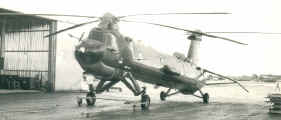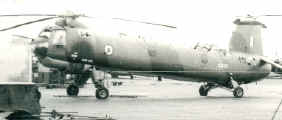Bristol Belvedere Helicopter Memories
| In December 2007 Damian Burrin told us about
his father, John Burrin, who joined the RAF in 1952 and retired
as a C/Tech in 1978 after serving in many parts of the world. John was stationed at RAF Seletar, in Singapore, until No.66 Squadron disbanded on 20th March 1969 and was able to film a ceremonial flypast of eleven of the Squadron's Bristol 192 Belvederes on 27th October 1967. Damian has recently digitised a lot of his father's cine film and has made some helicopter footage available to us, including a Wessex, a single Belvedere and the Belvedere flypast. He says that his father also has some good quality still photos of Belvederes which are being sorted. We hope that John Burrin will agree to write down some of his memories, illustrated by his photos, for us to publish on these pages. |
| In May
2002 Keith Hyde e-mailed us from Toronto describing some of his
experiences with the RAF when servicing Belvederes
in Borneo in 1965-66, during the war against Sukarno. He says:- "I was stationed in Kuching engaged on front-line servicing and major overhauls of the Belvederes, attached to No.66 Squadron, in pretty awful conditions". "Engine changes in the cramped confines of the fuselage were trying, to say the least, in the humid climate". "I clearly remember problems with servicing the rotor heads, blade tracking and terrible problems with the cartridge engine start system". "What a wonderful time flying low over the jungle with the loading door open and looking down at the small jungle villages. I can still hear the sound of the twin-rotor blades cutting through the very humid air in Borneo". Thanks to Keith for allowing us to quote his words. |
||
 |
 |
|
In October 2002 Robbie Taylor saw Keith Hyde's letter on this site and generously sent us some photographs taken during his service at RAF Kuching, also in 1965/66. These included two showing Belvederes (above). The one on the left is not identified, the one on the right appears to be XG476. Robbie was in the Supply, Control and Accounting Flight of the Supply Squadron in Kuching. He tells us that he was involved in the supply of Belvedere spares for 66 Squadron and was often able to fly with them on supply missions to forward areas. With the agreement of both we put Keith and Robbie in touch, by e-mail, and hope they enjoyed exchanging their Borneo memories. A rather different memory
was recalled for us by Derek Palmer, until recently one of the
"Wednesday Gang" at The Museum, who restored the Kamov
Ka-26, DDR-SPY, and have recently restored the nose section of
Belvedere XG462. "By the end of the Auster's second repair one of the early Belvederes from the RAF's No.26 Squadron had arrived in Aden on 'hot and high' trials and this provoked some bright spark to suggest that the Auster's fuselage be taken back to Falaise slung on the hook beneath the Belvedere. Not only would this enable its return but also provide a useful hot weather task for the Belvedere. Up to that time there had been no helicopters serving in Aden, so the distinct noise of one, flying close by, drew almost all of 653 squadron personnel out to the airfield to watch the proceedings". "The pilot made one approach to familiarise himself with the ‘field’. On the second approach the Belvedere hovered in front of the audience before starting to descend. I do recall some wag in the crowd saying, 'What’s the betting they drop it?'. When the Auster fuselage was still approximately ten feet above the runway, descent stopped and, to the consternation of all, it was released. Its tailplane flapped dramatically down ending with the tips almost touching the ground. The undercarriage was squeezed rapidly upwards for it had never been designed to take such a short landing, not even from trainee Army Air Corps pilots! And one can only imagine the shock loading to the new engine!" "I believe an Air Loadmaster had positioned himself at the window halfway down the pencil shaped Belvedere where he gave instructions to the pilot as to position, descent, load touch down and hook release. The story goes, and I cannot vouch for its veracity, that at around ten feet the Air Loadmaster had coughed. The pilot thought he heard ‘Drop’, went into the hover and released the hook!" "Needless to say the Auster went back to the M.U. for the third time, and I never saw it again for by then I was flying the Immortal Beaver."
In September 2008 we received an email from John Cowley, in South Africa, with some very interesting additions to Derek Palmer's memories. "I feel obliged to add to the memories of Derek Palmer and the dropped Auster at Falaise airfield, Little Aden on 4th June 1963. I happened to be the crewman on that aircraft (XG457) that day and I believe the Inquiry concluded that I (a mere corporal at the time) "may" have coughed at the crucial moment (why me ?). Well, I didn't cough, but I believe it was seen as the best way out of an embarrassing situation, and I did agree that it was possible"."'Release' was the only term ever used, 'Cut' (or something sounding like that) was a no-go. It was certainly released by the crew, I believe on the manual lever situated high on the cockpit bulkhead. The normal procedure was for the pilot to release the load using a switch on the cyclic column, and the copilot to backup on the manual lever if necessary". "As established on the first run, the Auster was a 'spinner' in the hover and it would be necessary to put it down whilst moving forwards. This is not difficult but does require good timing and technique, and the release must happen when called for, which makes pilots nervous. We were well short of the drop zone (ironic term) when the Auster was released and the sight of the Auster hitting the ground, viewed from above, is burned into my memory". "My conclusion is that whoever was doing backup using the manual release lever, with his hand resting on the lever behind him and over his shoulder, inadvertently moved the lever far enough to release the load". |
||
| Return to Belvedere XG452 Restoration | ||
